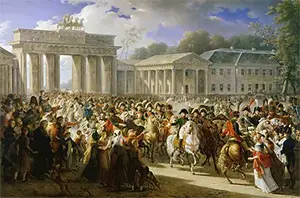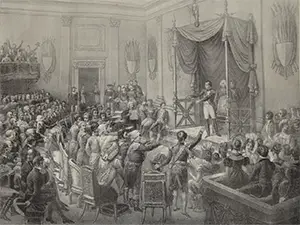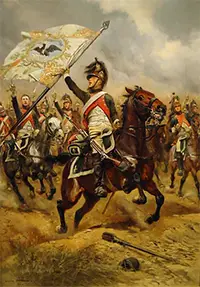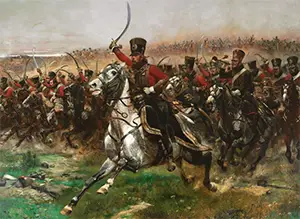Napoleon Bonaparte: Giant of the Age
Part 7: Triumph in Germany
For all of its political structure, the Confederation of the Rhine was designed to be a buffer state between France and Austria (and the rest of Europe), and the residents of that Confederation certainly supplied the French Empire with manpower and money. A mere two months after the declaration of the Confederation, Prussia declared war on France. This began the War of the Fourth Coalition. Not waiting for an invasion, Napoleon launched an attack of his own. French troops smashed through Prussian defenses and right away inflicted heavy losses, including Prince Louis Ferdinand, the nephew of Prussia's King Frederick-William III, who was killed on October 10 at the Battle of Saalfeld. Prussia retreated and recovered and then committed large numbers of men and weapons to a pair of battles that occurred on the same day, Oct. 14, 1806. At both Auerstädt and Jena, French armies scored overwhelming victories, with Marshal Louis-Nicolas Davout winning big at the former despite being heavily outnumbered. Aiding the French victory at Jena was the timely arrival and quick thinking of Marshal Jean Lannes, who arrived with a small force and occupied the town, then seized the high ground surrounding the town. In the face of determined opposition by a larger Prussian force, Lannes's small force kept control of that position, even to the extent of widening and deepening an existing path in order to facilitate the dragging of artillery up onto the heights. 
The battle commenced early the next morning, with French attacks against the Prussian flanks, giving the main French army an opportunity to get into prime position to make a push. The French made that push and drove the Prussians back, steadily then haltingly. In the midst of a trend toward the French Army gaining steady ground, Marshal Michel Ney and his men charged straight into the battle, driving a wedge so far into the Prussian lines that they found themselves surrounded. Bonaparte, who was with this force and not at Auerstádt, ordered Marshal Jean Lannes's troops to shift from the center and rescue Ney, while also plugging the gap created from the shift of Lannes's troops with the Imperial Guard. The French reinforcements fought their way through to Ney's trapped men and got them out of trouble. With so much focus on that aspect of the battle, Prussian troops could have then counterattacked and likely scored a victory; instead, they waited. With Ney and his men out of immediate danger and Lannes and his men ready to refocus, Bonaparte ordered a hard charge from all across the line. In prime position was Marshal Joachim Murat. The result was a fleeing Prussian army, which lost 10,000 of its numbers in killed or wounded. In addition, the victorious French soldiers claimed 15,000 prisoners and 150 guns. Meanwhile, the other main French force, which had fewer numbers in both men and weapons, was at Auerstädt, at which was a much larger Prussian force–in fact, this was the main part of the Prussian Army, under the overall command of the Duke of Brunswick and battlefield command of Friedrich Wilhlem Carl von Schmettau. Commanding the French forces was Marshal Louis Nicolas Davout. Prussia's King Frederick William III was with the main force, which numbered more than 60,000. Davout had 27,000 men in his force; the other French commander, Jean-Baptiste Bernadotte, had 20,000 men. Both commanders had been given orders to go to Jena because Bonaparte thought that he was facing the main Prussian army. They took different routes to get there, and Bernadotte succeeded in breaking free from the Prussian guard. That left Davout, who could not break out, along to face a Prussian force more than twice his size. The French army, however, was experienced and well trained and, after several years of fighting under Bonaparte, used to doing things quickly, like fast marching and reacting to rapidly changing orders no matter the situation. In addition, the French chain of command was a rigid Bonaparte was overjoyed when he heard of the victory at Auerstädt as well. He was not amused when Bernadotte and his men arrived at Jena, having missed both battles. 
Those battles occurred on October 14. Less than two weeks later, French armies captured Berlin. Relentless cavalry pursuit directed by Murat harried the Prussian retreat, ragged though it was. At Halle three days later, Bernadotte won a convincing army over another Prussian army, under the Duke of Württemberg. Just a few weeks later, the last Prussian defenses capitulated at Lubeck, and the Prussian king fled to Russia. He did not surrender. French forces continued in their pursuit into Poland, capturing Warsaw and defeating the Russian Army on Feb. 8, 1807, at the Battle of Eylau, which was fought in a blinding snowstorm. In that nondecisive battle, casualties numbered in the tens of thousands. Both sides settled in for winter. Yet another overwhelming French victory came on June 14, 1807, at Friedland, prompting Russia to surrender. In that battle, quick thinking by Lannes forced the Russian commander, Gen. Leonty Leontyevich Bennigsen, to mass his troops in one spot, making them easier to attack. Lannes had enticed the larger Russian force to The resulting Treaty of Tilsit, signed on July 7, took both Prussia and Russia out of the war, levied Prussia with a huge indemnity, and required both powers to give up territory. The borders of the Confederation of the Rhine widened, and French territory soon included the newly created Duchy of Warsaw. Next page > Continental System and Opposition > Page 1, 2, 3, 4, 5, 6, 7, 8, 9, 10, 11, 12 |
|
Social Studies for Kids
copyright 2002–2025
David White



 At first, the Confederation contained 16 German states, which joined on July 12, 1806; another 19 joined later. At its height, the Confederation contained 15 million people. On August 1, 1806, the original member states left the Holy Roman Empire. Just five days later, Emperor Francis II declared himself as emperor of Austria only. The Holy Roman Empire, which had existed for a millennium, was no more.
At first, the Confederation contained 16 German states, which joined on July 12, 1806; another 19 joined later. At its height, the Confederation contained 15 million people. On August 1, 1806, the original member states left the Holy Roman Empire. Just five days later, Emperor Francis II declared himself as emperor of Austria only. The Holy Roman Empire, which had existed for a millennium, was no more. one and many of its troops were still fighting with the revolutionary zeal that had marked earlier wars against the monarchical powers of Europe. The Prussian army was none of these things, and that cost them in this battle quite heavily. An excess of commanders on the Prussian side led to confusion in battle and costly delays in the carrying out of orders, such that the fighting cost the lies of two Prussian commanders, the Duke of Brunswick and Schmettau. The initial success in French troops' defense against Prussian cavalry charges convinced the Prussian command to not only call off any further cavalry charges but also to order the infantry to fall back. It wasn't until well until the battle that the Duke of Brunswick had ordered a full-press attack, which might have been successful if employed at the start of the fighting. Davout, meanwhile, had a better sense for how the battle was progressing and, even though he was outnumbered, ordered a fierce counterattack that drove the Prussians from the field. Prussian casualties overall were 13,000; French losses numbered just more than half of that.
one and many of its troops were still fighting with the revolutionary zeal that had marked earlier wars against the monarchical powers of Europe. The Prussian army was none of these things, and that cost them in this battle quite heavily. An excess of commanders on the Prussian side led to confusion in battle and costly delays in the carrying out of orders, such that the fighting cost the lies of two Prussian commanders, the Duke of Brunswick and Schmettau. The initial success in French troops' defense against Prussian cavalry charges convinced the Prussian command to not only call off any further cavalry charges but also to order the infantry to fall back. It wasn't until well until the battle that the Duke of Brunswick had ordered a full-press attack, which might have been successful if employed at the start of the fighting. Davout, meanwhile, had a better sense for how the battle was progressing and, even though he was outnumbered, ordered a fierce counterattack that drove the Prussians from the field. Prussian casualties overall were 13,000; French losses numbered just more than half of that. concentrate on his much larger force, on the west bank of the Alle River, and, further, had held off the much larger force for most of the day until Bonaparte could assemble the rest of the Grand Armée for a counterattack. When the two large armies crashed into each other, 80,000 Frenchmen were fighting 58,000 Russians. The French made good on a push to drive the Russian troops into the town of Friedland and then trapped them there. French artillery proved superior yet again, scattering Russian troops and forcing many of them to try to escape by crossing the river; many drowned. Russia lost one-third of its force to death and injuries; French losses were 9,000.
concentrate on his much larger force, on the west bank of the Alle River, and, further, had held off the much larger force for most of the day until Bonaparte could assemble the rest of the Grand Armée for a counterattack. When the two large armies crashed into each other, 80,000 Frenchmen were fighting 58,000 Russians. The French made good on a push to drive the Russian troops into the town of Friedland and then trapped them there. French artillery proved superior yet again, scattering Russian troops and forcing many of them to try to escape by crossing the river; many drowned. Russia lost one-third of its force to death and injuries; French losses were 9,000.
